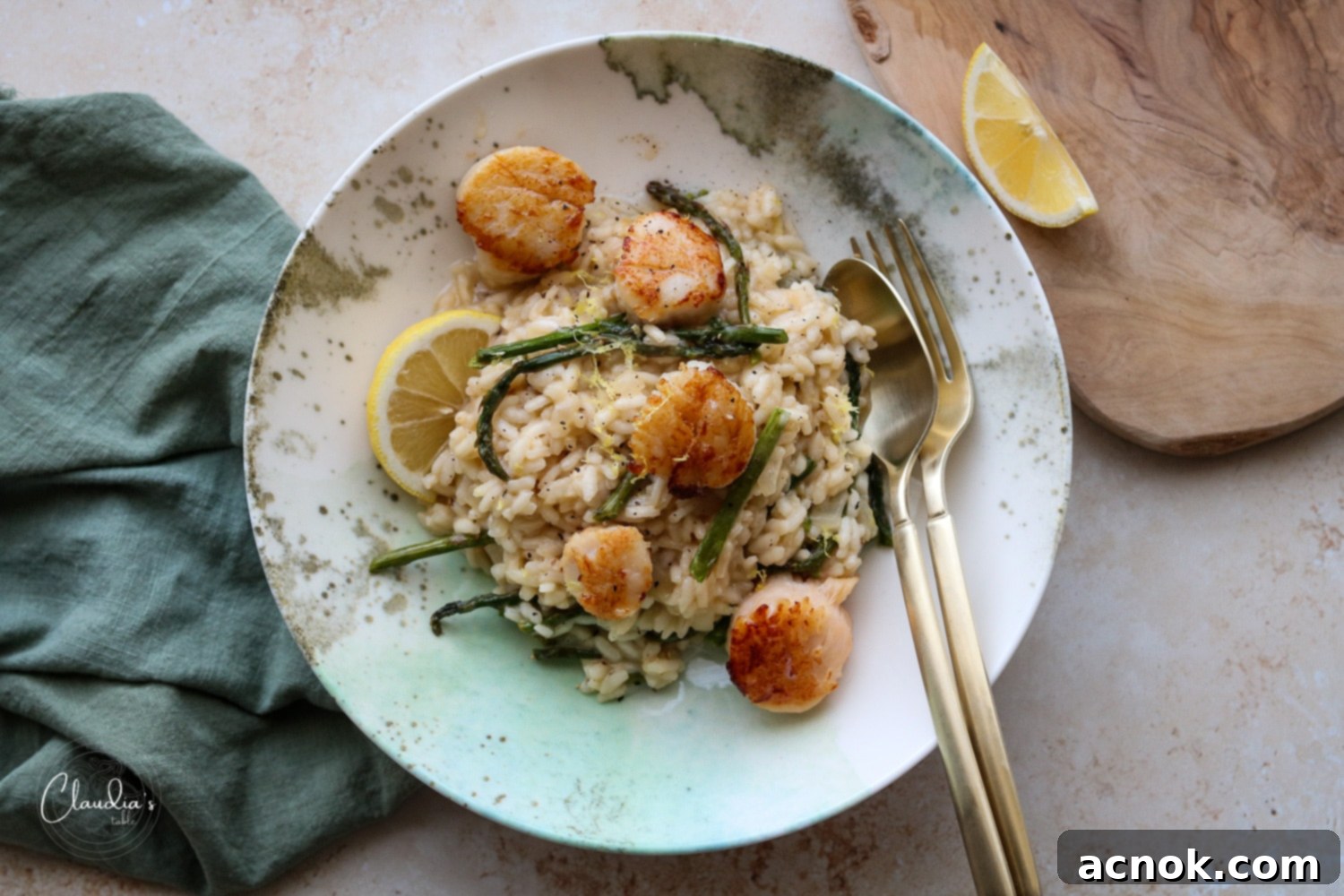The Ultimate Gourmet Delight: Creamy Lemon Parmesan Risotto with Perfectly Seared Asparagus and Scallops
Imagine a culinary masterpiece gracing your table: a vibrant, perfectly cooked risotto, intensely creamy and infused with the bright zest of lemon and the subtle sweetness of tender asparagus. This luscious base is crowned with golden-brown, pan-seared scallops – crispy on the outside, incredibly tender and succulent within. This isn’t just a meal; it’s an experience, a symphony of textures and flavors that will impress guests and delight your palate. Brace yourselves, because we’re about to embark on a journey of pure deliciousness with our comprehensive guide and mouthwatering recipe for this exquisite Creamy Lemon Parmesan Risotto with Asparagus and Seared Scallops. This dish brings gourmet dining right into your home kitchen, proving that elegance can be achieved with a little patience and the right techniques.
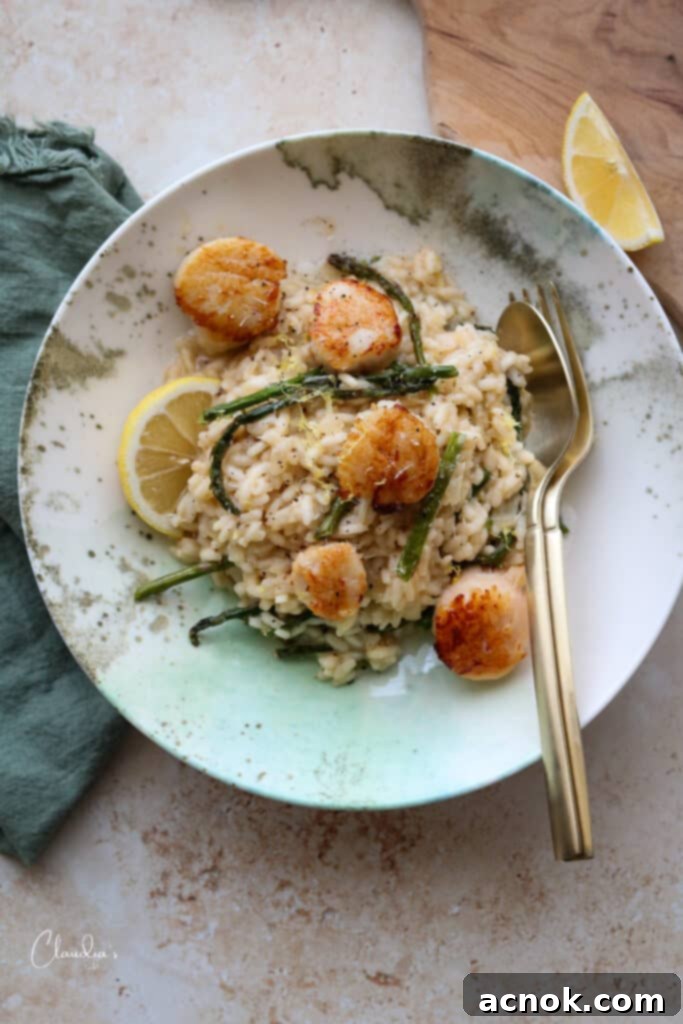
Table of Contents
- What is the Secret to the Best Risotto?
- What is the Best Rice for Risotto?
- Essential Ingredients for Creamy Risotto with Asparagus and Seared Scallops
- Suggested Kitchen Equipment for Making This Risotto
- How to Master Lemon Parmesan Risotto
- How to Perfectly Pan-Sear Scallops
- Serving Creamy Risotto with Asparagus and Seared Scallops
- Frequently Asked Questions, Tips, and Substitutes
What is the Secret to the Best Risotto?
This lemon parmesan risotto recipe is truly a personal favorite. It’s incredibly creamy, richly decadent, and bursting with authentic Parmesan flavor. Beyond its spectacular taste, its versatility is unmatched, making it a perfect companion for a wide variety of proteins. While this recipe is not about shortcuts – it absolutely requires consistent stirring – the effort is undoubtedly worth the reward. Consider it a delightful “workout” for your wrist, culminating in an unparalleled culinary experience.
The foremost secret to a truly delicious risotto lies in patience. Unlike cooking regular rice, risotto demands a gradual, almost meditative process of adding liquid and stirring. This continuous stirring, combined with precise heat control, is what coaxes the rice grains to slowly absorb the broth while releasing their starches. This starch release is the magical key to achieving that signature velvety, creamy consistency that risotto is famous for, ensuring the rice plumps up beautifully and cooks to a tender, yet still slightly firm, “al d’ente” bite.
My final, but equally crucial, tip is to never skimp on freshly grated Parmigiano Reggiano cheese. The difference in flavor between freshly grated, high-quality Parmesan and pre-shredded varieties is monumental. Pre-shredded cheeses often contain anti-caking agents that can dull their flavor and affect the texture of your dish. Freshly grated Parmigiano Reggiano offers a sharper, more complex, and aromatic taste that truly elevates the entire risotto. It melts seamlessly into the sauce, enhancing the richness and depth of flavor. If authentic Parmigiano Reggiano is hard to find, a good quality, freshly grated American Parmesan is a fine alternative, but the authentic Italian variety is truly a game-changer.
What is the Best Rice for Risotto?
When it comes to crafting the perfect risotto, the choice of rice is paramount, and Arborio rice stands out as the ideal candidate. There are two primary reasons for its widespread recommendation: first, its accessibility – it’s readily available in most major grocery stores, often found in the Italian specialty or international foods aisle. Second, and perhaps more importantly, it’s remarkably foolproof, making it an excellent choice for home cooks of all skill levels.
While I have experimented with Carnaroli rice, which I’ve sourced from specialty Italian markets like Eataly, I consistently find that Arborio rice delivers outstanding results, being both forgiving and reliable. The question often arises: why can’t you just use regular long-grain rice for risotto? The answer lies in the specific characteristics of risotto rice. These are typically starchy, medium-grain Italian varieties specifically bred for this dish.
During the cooking process, as liquid is gradually absorbed, these rice grains plump up beautifully. Crucially, they also release a significant amount of amylopectin, a type of starch, into the cooking liquid. This released starch is what creates the luxurious, creamy consistency of the finished risotto, binding all the ingredients together into a cohesive, velvety dish. Unlike long-grain rice which tends to cook into separate grains, risotto rice forms a harmonious, rich sauce around each tender kernel.
Risotto, in general, is a remarkably adaptable dish. Once you master the basic technique, you can easily customize it with a variety of vegetables, proteins, and flavor profiles to suit any taste or occasion. Feel free to experiment with different seasonal produce or your favorite seafood and meats. For more in-depth information on risotto rice and its unique properties, you can explore my Easy Pumpkin Risotto recipe post, which delves further into the science and selection of the best rice for your perfect risotto.
Essential Ingredients for Creamy Risotto with Asparagus and Seared Scallops
Crafting this elegant dish begins with a selection of fresh, high-quality ingredients. Each component plays a vital role in building the layered flavors and achieving the perfect texture. Here’s what you’ll need for your creamy lemon parmesan risotto with roasted asparagus and perfectly seared scallops:
- 1/2 pound of fresh asparagus, roasted and cut into 2-inch pieces
- A light drizzle of high-quality olive oil (for asparagus)
- 2 cups of Arborio rice, essential for its starchy properties and creamy texture
- 6 cups of vegetable or chicken broth, gently warmed to a slow simmer (warm broth is key for even absorption)
- 1/2 cup of dry white wine, such as Sauvignon Blanc or Pinot Grigio, to deglaze and add depth
- 1/2 yellow onion, finely chopped for a delicate flavor base
- 5 tablespoons of unsalted butter, divided for richness in both risotto and scallops
- 3/4 cup of freshly grated *Parmigiano Reggiano cheese (see note below for details)
- Juice of 1/2 fresh lemon, to brighten and balance the richness
- Zest of half a lemon, for an aromatic burst of citrus flavor
- 1/2 teaspoon Kosher salt, plus an additional pinch for seasoning scallops and asparagus
- 1/4 teaspoon freshly ground black pepper, for a hint of warmth
- 1 pound large or extra-large dry, sea scallops. It’s crucial they are patted very dry to achieve a perfect sear.
- 1 tablespoon olive oil (for searing scallops)
- Lemon cut into wedges for serving, for an optional fresh squeeze at the end
*Note on Cheese: To truly elevate the flavor profile of your risotto, we highly recommend using freshly grated Parmigiano Reggiano. Its complex, nutty, and savory notes are unparalleled. If authentic Parmigiano Reggiano is unavailable, a freshly grated American Parmesan will work beautifully, offering a similar salty and umami depth, just ensure it’s grated fresh from the block for the best flavor and melting quality. Avoid pre-shredded varieties for optimal results.
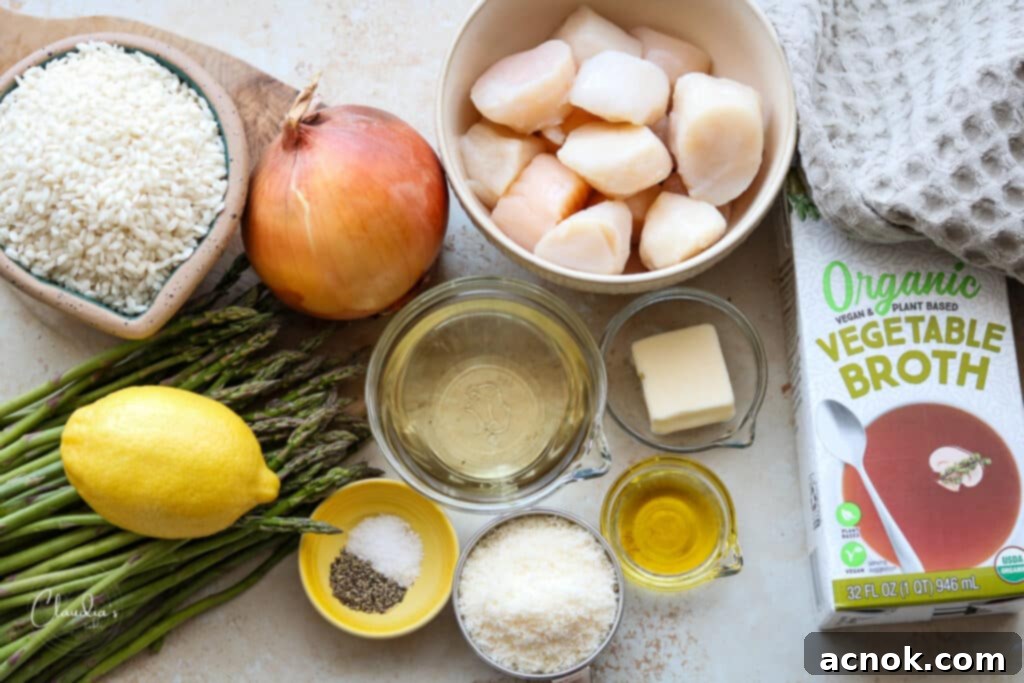
Suggested Kitchen Equipment for Making This Risotto
Having the right tools can make all the difference in achieving culinary success and ease. For your risotto, I highly recommend a large, wide skillet or a Dutch oven. The wide surface area promotes even cooking and liquid evaporation, which is crucial for developing the creamy texture. Additionally, a small, 2-quart saucepan is essential for keeping your broth at a gentle simmer throughout the risotto-making process, ensuring it’s always ready to be added.
For perfectly pan-seared scallops, the best piece of kitchen equipment is a heavy-bottomed stainless steel skillet or a cast iron pan. These materials retain heat exceptionally well and distribute it evenly, which is critical for achieving that beautiful, golden-brown crust. A nonstick pan can also work effectively, but ensure it’s capable of reaching a high temperature without damaging the coating. A sturdy wooden spoon for stirring the risotto is also invaluable.
How to Master Lemon Parmesan Risotto
The key to a successful risotto lies in preparation, often referred to as “mise en place.” It’s imperative to have all your ingredients prepped, measured, and ready to go before you even start cooking. While you gather your ingredients, begin by heating the vegetable or chicken broth in a small saucepan to a slow simmer. Once simmering, reduce the heat to maintain a low, consistent warmth throughout the cooking process. This ensures your broth is always hot, preventing it from cooling down the rice and interrupting the cooking.
**Roasting the Asparagus:**
Preheat your oven to 400°F (200°C).
Wash and thoroughly dry the asparagus spears. Place them on a baking sheet, drizzle lightly with olive oil, and sprinkle with a pinch of Kosher salt. Roast for approximately 20 minutes, or until the asparagus is tender-crisp and slightly browned. If you are using very thin asparagus, check for doneness after about 10 minutes to prevent overcooking. Once roasted, remove from the oven, chop into 2-inch pieces, and set aside.
**Building the Risotto Base:**
Preheat a heavy, wide saucepan or a Dutch/French oven over medium heat. The wide surface area is important for even cooking and stirring.
Note about stove heat for risotto
Many modern stoves, particularly those with larger burners, can run quite hot even on a “medium” setting. For this delicate dish, if you have an extra-large burner, it’s advisable to set it to medium-low. The heat should be consistently warm enough to keep the risotto mixture active and simmering gently, allowing the liquid to absorb steadily, but not so high that it boils rapidly and cooks down too quickly, preventing proper starch release and tender rice.
Add 2 tablespoons of unsalted butter to the preheated pan. Once the butter has melted and is shimmering, add the finely chopped onion and sauté gently. Allow the onion to soften and become translucent, which typically takes about 4 minutes. It’s important not to brown the onions, as this can add a bitter flavor. Next, add the Arborio rice to the pan. Sauté the rice for about 1 minute, stirring continuously, ensuring each grain is thoroughly coated with the butter and onion. This step is called “toasting” or “tostatura” and helps seal the outer layer of the rice, allowing it to absorb liquid slowly and remain al d’ente, but be careful not to actually toast or brown the rice.
**The Gradual Absorption Process:**
Pour in the dry white wine and stir continuously. The wine will rapidly evaporate, leaving behind its delicate flavor, which deglazes the pan and adds depth to the risotto. Continue stirring until the wine has almost completely evaporated, about 3 minutes. This process adds a layer of acidity and complexity.
Now begins the heart of the risotto-making process: the gradual addition of broth. Add 1/2 cup of the simmering broth to the rice mixture and stir. Stir consistently, gently scraping the bottom of the pan, until the broth has been almost completely absorbed by the rice. You’ll notice the mixture thickening. Then, add another 1/2 cup of simmering broth and continue to stir until it, too, is almost completely absorbed. The rhythmic stirring is crucial as it helps to slough off the starch from the rice grains, which is what creates that signature creamy texture.
Repeat this process, adding 1/2 cup of broth at a time and stirring until almost fully absorbed before adding the next. The key is for the rice to slowly absorb the liquid, allowing the starches to release and thicken the mixture, and for the rice to cook through until it’s tender yet still has a slight chew (al d’ente). This entire process typically takes about 20 minutes. As you continue, you will observe the risotto transforming, becoming progressively thicker, richer, and creamier.
**Finishing Touches:**
Approximately 5 minutes before the risotto is fully cooked, begin preheating your skillet for searing the sea scallops, ensuring it gets very hot.
Once the risotto has reached its perfect creamy, tender consistency, remove it from the heat. Stir in the remaining 2 tablespoons of unsalted butter, the roasted asparagus pieces, the fresh lemon juice, lemon zest, and the freshly grated Parmigiano Reggiano cheese. Stir gently but thoroughly until all ingredients are fully combined, the butter has melted, and the risotto is beautifully creamy and thick. Taste and adjust seasoning with Kosher salt and freshly ground black pepper as needed. The lemon juice and zest provide a wonderful counterpoint to the richness of the cheese and butter.
How to Perfectly Pan-Sear Scallops
Achieving a perfect golden-brown sear on scallops is a simple technique that yields impressive results, but it relies on a few critical steps. First and foremost, ensure your scallops are thoroughly patted dry with paper towels. Any excess moisture will prevent a good sear and cause them to steam instead of caramelize. If your scallops feel wet, pat them dry, let them sit for a few minutes, then pat dry again.
Preheat a heavy-bottomed skillet (stainless steel or cast iron are ideal) over high heat until it is smoking hot. The pan must be very hot to achieve the Maillard reaction – the chemical process responsible for that delicious browned crust. Add 1 tablespoon of olive oil to the hot skillet, ensuring the entire bottom surface is coated. The oil should shimmer and almost smoke immediately.
Carefully place the scallops onto the hot skillet one at a time, making sure to leave enough space between them. Do not crowd the pan! Crowding the pan will lower its temperature, causing the scallops to release their moisture and steam rather than sear, resulting in a rubbery texture and no beautiful golden crust. Cook in batches if necessary. Season the exposed side of the scallops with a pinch of Kosher salt.
Sear the scallops for approximately 2 minutes without moving them. This allows a crust to form. After 2 minutes, the scallops should release easily from the pan on their own and reveal a gorgeous golden-brown sear. Flip each scallop. Immediately add 1 tablespoon of unsalted butter to the pan. The butter will melt and brown, adding incredible richness and flavor to the second side of the scallops. Continue searing for about 1 to 2 more minutes, or until the second side is also golden-brown and the scallops are opaque throughout but still translucent in the very center, indicating they are perfectly cooked and tender.
Serving Creamy Risotto with Asparagus and Seared Scallops
The beauty of this dish is that the risotto and scallops are designed to finish cooking at approximately the same time, ensuring everything is fresh and hot for serving. To plate this exquisite meal, spoon about two cups (or one-quarter of the total risotto) of the warm, creamy lemon parmesan risotto with asparagus into shallow bowls. Artfully arrange a quarter of the perfectly seared scallops on top of the risotto. For a final flourish, generously top each serving with an extra sprinkle of freshly grated Parmigiano Reggiano cheese and a fresh squeeze of lemon juice. The lemon provides a final bright note that cuts through the richness and enhances the flavors of the seafood and asparagus. Serve immediately to enjoy the peak freshness and texture of this truly special dish.
This elegant creamy risotto with asparagus and seared scallops pairs wonderfully with a simple, refreshing Green Salad or my robust Grilled Romaine and Radicchio Caesar Salad for a complete and satisfying meal. A crisp, dry white wine like Sauvignon Blanc or Pinot Grigio would also complement the flavors beautifully.
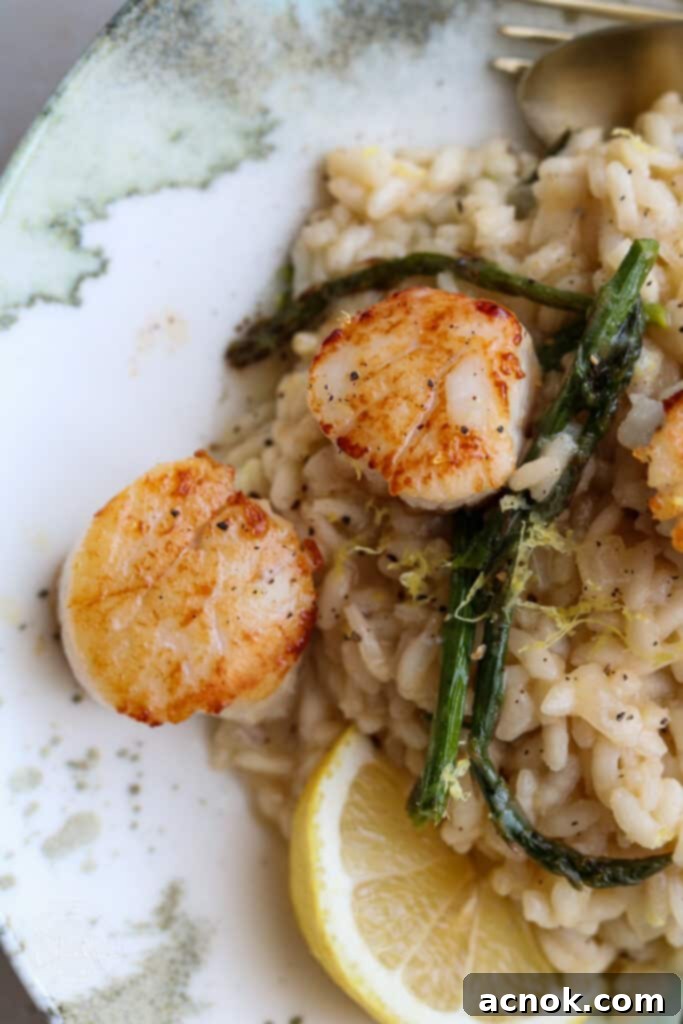
Frequently Asked Questions, Tips, and Substitutes
Absolutely! This versatile risotto base pairs beautifully with a variety of proteins. Pan-seared shrimp or salmon are excellent substitutes for scallops, offering similar quick cooking times and complementary flavors. You could also consider grilled chicken breast, or even a robust portobello mushroom for a vegetarian option.
While Arborio is highly recommended for its ideal starch content and texture, if you’re unable to find it, Carnaroli rice is considered by many chefs to be the superior risotto rice, offering even creamier results. Bomba or Calrose rice can also work as reasonable substitutes, though they may yield a slightly different texture than traditional Arborio.
Certainly! The beauty of risotto is its adaptability. The following vegetables work exceptionally well in this recipe: roasted broccoli florets, tender roasted Brussels sprouts, vibrant cooked peas (stirred in at the very end), or sautéed green beans. Choose what’s seasonal and fresh for the best flavor.
Yes, this creamy risotto can be easily adapted to be vegan. Simply substitute the unsalted butter with a high-quality vegan butter alternative, use vegetable broth, and incorporate a reputable vegan parmesan cheese substitute. For the topping, you can use any of the vegetable variations mentioned above instead of scallops.
For best results, I recommend storing cooked scallops and risotto separately. Place cooked scallops in an airtight container. To reheat, gently warm them in a pan on the stovetop over low heat until just warmed through, taking care not to overcook them. For the risotto, place it in another airtight container. When reheating, transfer the risotto to a pan on the stovetop, add a small splash of vegetable broth or water to restore its creaminess, and heat gently over low heat, stirring occasionally, until thoroughly warmed.
For risotto, you’ll want a dry white wine that you enjoy drinking. Sauvignon Blanc, Pinot Grigio, and unoaked Chardonnay are excellent choices. They offer a crisp acidity that helps to deglaze the pan and adds a bright, balanced flavor without overpowering the other ingredients. Avoid sweet wines as they will alter the flavor profile of the dish significantly.
While risotto is best enjoyed fresh off the stove, you can prepare some components in advance. The asparagus can be roasted and chopped a day ahead and stored in the refrigerator. You can also have your broth warmed and your onion chopped and ready. For the risotto itself, it’s best cooked just before serving to maintain its creamy texture. Scallops also should be seared immediately before serving.
If you tried this exquisite recipe, please help other readers by commenting below and sharing some stars! We 🫶🏼 appreciate you!
All content and photographs ©Claudia’s Table and claudiastable.com
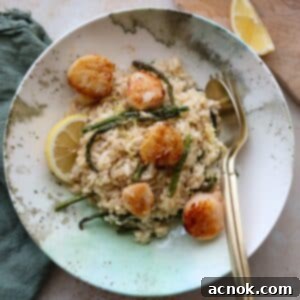
Creamy Risotto with Asparagus and Seared Scallops
Ana | Claudia’s Table
December 6, 2023
Pin Recipe
Equipment
-
1 Dutch Oven or heavy bottom pan for risotto
-
1 skillet, large for scallops
-
1 saucepan 2 quart
-
1 baking sheet for asparagus
Ingredients
Roasted Asparagus
- 1/2 pound of Asparagus roasted and cut into 2-inch pieces
- olive oil drizzle
Risotto
- 2 cups Arborio rice Italian specialty rice for risotto
- 6 cups vegetable or chicken broth warmed to a simmer
- 1/2 cup white wine dry
- 1/2 yellow onion finely chopped
- 3/4 cup Parmigiano Reggiano cheese freshly, grated
- 5 tablespoons butter, unsalted divided
- 1/2 fresh lemon juice of
- 1/2 lemon zest of
- 1/2 teaspoon Kosher salt
- 1/4 teaspoon freshly ground pepper
Pan Seared Scallops
- 1 pound sea scallops, large or extra large dry Patted dry.
- 1 tablespoon olive oil
- 1 whole Lemon cut into wedges for serving
Instructions
Prepare Broth and Asparagus
-
In a small saucepan, heat the vegetable or chicken broth to a gentle simmer, then reduce heat to keep it warm. This ensures it’s ready for gradual addition to the risotto.
-
Preheat oven to 400°F (200°C) for roasting the asparagus.
-
Wash and thoroughly dry asparagus spears. Place them on a baking sheet, drizzle with a little olive oil, and add a pinch of Kosher salt.
-
Roast for about 20 minutes or until tender-crisp. For very thin asparagus, roast for about 10 minutes. Remove from oven, chop into 2-inch pieces, and set aside.
Craft the Creamy Parmesan Risotto
-
Preheat a heavy, wide saucepan or Dutch oven over medium heat.
-
Add 2 tablespoons of unsalted butter. Once melted, add the finely chopped onion and sauté for about 4 minutes until translucent, not browned. Add Arborio rice and sauté for 1 minute, ensuring each grain is coated.
-
Pour in the dry white wine and stir until it has almost completely evaporated, about 3 minutes.
-
Add 1/2 cup of the simmering broth and stir constantly until almost completely absorbed. Repeat with another 1/2 cup of broth.
-
Continue adding broth 1/2 cup at a time, stirring constantly and allowing each addition to be almost fully absorbed before adding the next. This gradual process and continuous stirring helps release starch for a creamy texture and ensures tender rice.
-
The entire process will take approximately 20 minutes, yielding a thick, creamy, and tender risotto.
-
About 5 minutes before the risotto is finished, begin preheating the skillet for your sea scallops.
-
Once done, stir in 2 tablespoons of unsalted butter, the roasted asparagus pieces, lemon juice, lemon zest, and freshly grated Parmesan cheese. Stir gently until all ingredients are combined and the risotto is creamy and thick. Season with salt and fresh ground pepper to taste.
Perfectly Pan-Sear the Scallops
-
Ensure scallops are thoroughly patted dry. Preheat the skillet until very hot (almost smoking). Add 1 tablespoon of olive oil, ensuring the entire bottom is covered. Carefully place scallops onto the hot skillet, leaving ample space between them to avoid steaming. Add a pinch of Kosher salt.
-
Sear scallops for about 2 minutes until a golden-brown crust forms and they release easily. Flip them over, add 1 tablespoon of butter to the pan, and sear for another 1-2 minutes until golden on the second side and opaque throughout.
Serve and Enjoy
-
The risotto and scallops should finish cooking simultaneously. In shallow bowls, spoon about two cups of the creamy risotto. Arrange a quarter of the pan-seared scallops elegantly on top.
-
Garnish with an extra sprinkle of freshly grated Parmigiano Reggiano cheese and a fresh squeeze of lemon juice. Serve immediately and enjoy your gourmet creation!
Notes
Nutrition
Nutritional information is calculated online and should be used as a guide.
All content and photographs ©Claudia’s Table and claudiastable.com
Check out our New & Delicious Posts Below
- Pasta with Grilled Vegetables, Feta, and Lemon
- Grilled Asian Marinated Flank Steak
- Classic Homemade Chunky Blue Cheese Dressing
- 3-Ingredient Crispy Oven-Roasted Potatoes
- Grilled Peach Avocado Chicken Salad
